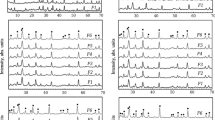Abstract
Kiln rollers’ grind waste powders (KRGW) collected from a ceramic factory are considered a high alumina waste consisting of several phases. The KRGW was treated hydrothermally at 150°C for different time periods. The hydrothermal method was found to be a very effective method for the management of KRGW in synthesizing new nanomaterials with new morphologies. Raw and treated kiln rollers’ grind waste was characterized using XRF, XRD, TEM, BET, DTA, and TGA. TEM of the raw KRGW showed a lamellar crystal structure with different shapes and morphologies. XRD displayed hour different phases with a high percentage of mullite and corundum due to the high levels of Al and Si in the raw waste. Treated KRGW exhibited nano-sieves with different morphologies consisting of two predominant phases, namely calcium aluminum oxide and corundum. Results indicated that the hydrothermal process assists phase changes, crystal size, and morphology of the KRGW. This modification is expected to improve over all properties of KRGW for efficient practical applications.
Similar content being viewed by others
References
Zimbili, O., Salim, W., Ndambuki, M.: A review on the usage of ceramic wastes in concrete production. Internat. J. of Civil, Architectural, Structural and Construction Engineering 8 (2014) [1] 91–95
Torgal, F.P., Jalali, S.: Reusing ceramic wastes in concrete. Construction and Building Materials 24 (2010) 832–838
Tabak, Y., Kara, M., Günay, E., Yildirim, S.T., Yilmaz, Ş.: Ceramic tile waste as a waste management solution for concrete. 3rd Internat. Conference on Industrial and Hazardous Waste Management (CRETE) (2012) 1–8
Medina, C., Sánchez, de Rojasb, M.I., Frías, M.: Reuse of sanitary ceramic wastes as coarse aggregate in eco-efficient concretes. Cement and Concrete Composites 34 (2012) [1] 48–54
Corominas, A., Etxeberria, M.: Properties of high performance concrete made with recycled fine ceramic and coarse mixed aggregates. Construction and Building Materials 68 (2014) 618–626
Halicka, A., Ogrodnik, P., Zegardlo, B.: Using ceramic sanitary ware waste as concrete aggregate. Construction and Building Materials 48 (2013) 295–305
Elçi, H.: Utilization of crushed floor and wall tile wastes as aggregate in concrete production. J. of Cleaner Production 112 (2016) [1] 742–752
Ji, R., Zhang, Z., He, Y., Liu, L., Wang, X.: Synthesis, characterization and modeling of new building insulation material using ceramic polishing waste residue. Construction and Building Materials 85 (2015) 119–126
Penteado, C., de Carvalho, E., Lintz, R.: Reusing ceramic tile polishing waste in paving block manufacturing. J. of Cleaner Production 112 (2016) [1] 514–520
Roushdy, M.H., Amin, Sh.K., Ahmed, M.M., Abadir, M.F: Reuse of the product obtained on grinding kiln rollers in the manufacture of ceramic wall tiles. Ceramics — Technical 38 (2014) 60–66
Gemmi, M., Merlini, M., Cruciani, G., Artioli, G.: Non-ideality and defectivity of the åkermanite-gehlenite solid solution: An X-ray diffraction and TEM study.Amer. Mineralogist 92 (2007) 1685–1694. DOI: 10.2138/am.2007.2380
Trindade, M.J., Dias, M.I., Coroado, J., Rocha, F.: Mineralogical transformations of calcareous rich clays with firing: A comparative study between calcite and dolomite rich clays from Algarve, Portugal. Applied Clay Science 42 (2009) 345–355. DOI:10.1016/j.clay.2008.02.008
Molenaar, J.M.M., Katgerman, L., Kool, W.H., Smeulders, R.J.: On the formation of the stircast structure. J. of Mater. Sci. 21 (1986) 389–394
Schulze, T.P., Davis, S.H.: Shear stabilization of morphological instability during directional solidification. J. of Crystal Growth 149 (1995) 253–265
Aras A.: The change of phase composition in kaolinite and illite-rich clay-based ceramic bodies. Applied Clay Sci. 24 (2004) [3–4] 257–269
Louisnathan, S.J.: Refinement of the crystal structure of a natural Gehlenite Ca2Al(AlSi)2O7. Canadian Mineral 10 (1971) 822–837
Lo, C.L., Duh, J.G., Chiou, B.S., Lee, W.H.: Microstructure characterization for Anorthite composite glass with nucleating agent of TiO2 under non-isothermal crystallization. Mater. Res. Bull. 37 (2002) 1949–1960
Riccardi, M.P., Messiga, B., Duminuco, P.: An approach to the dynamics of clay firing. Applied Clay Sci. 15 (1999) [3–4] 393–409
Sonuparlak, B., Sarikaya, M., Aksay, I.A.: Spinel phase formation during the 980°C exothermic reaction in the Kaolinite-to-Mullite reaction series. J. of the Amer. Ceram. Soc. 70 (1987) [11] 837–842
Seidel, H., Csepregi, L., Heuberger, A., Baumgartel, H.: Anisotropic etching or crystalline silicon in alkaline solutions, I. orientation dependence and behavior of passivation layers. J. of the Electrochemical Soc. 137 (1990) [11] 3612–3626
Dong, J., Huang, S.H.: Low-reflective surface texturing for large area multi-crystalline silicon using NaOH-NaCl solution. Surface Engineering and Applied Electrochemistry 50 (2014) [1] 25–29
Onutai, S., Wasanapiarnpong, T., Jiemsirilers, S., Wada, S., Thavorniti, P.: Effect of sodium hydroxide solution on the properties of geopolymer based on fly ash and aluminium waste blend. Suranaree J. of Sci. & Technology 21 (2014) [1] 9–14
Koros, W.J., Ma, Y.H., Shimidzu, T.: Terminology for membranes and membrane processes. Pure and Applied Chemistry 68 (1996) [7] 1479–1489
Jiang, Z., Yang, J., Ma H., Wang L., Ma X.: Reaction behavior of Al2O3 and SiO2 in high alumina coal fly ash during alkali hydrothermal process. Transactions of Nonferrous Metals Soc. of China 25 (2015) [6] 2065–2072. DOI: 10.1016/S1003-6326(15)63816-X
Brunaur, S., Deming, L.S., Deming, W.E., Teller, E.: On a theory of the Van der Waals adsorption of gases. J. of the Amer. Chemical Society 62 (1940) [7] 1723–1732
Gregg, S.J., Sing, K.S.W.: Adsorption, Surface Area, and Porosity. 2nd Edition, Academic Press INC, London, ISBN 0-12-300956-1 (1982)
Sing, K.S.W., Everett, D.H., Haul, R.A.W., Moscou, L., Pierotti, R., Rouquerol, J., Siemienwska, T.: Reporting physisorption data for gas/solid systems with special reference to the determination of surface area and porosity. Pure and Applied Chemistry 57 (1985) [4] 603–619
Author information
Authors and Affiliations
Corresponding author
Rights and permissions
About this article
Cite this article
Abo-Almaged, H.H., Moustafa, A.F., Ismail, A.M. et al. Hydrothermal Treatment Management of High Alumina Waste for Synthesis of Nanomaterials with New Morphologies. Interceram. - Int. Ceram. Rev. 66, 172–179 (2017). https://doi.org/10.1007/BF03401212
Received:
Published:
Issue Date:
DOI: https://doi.org/10.1007/BF03401212




